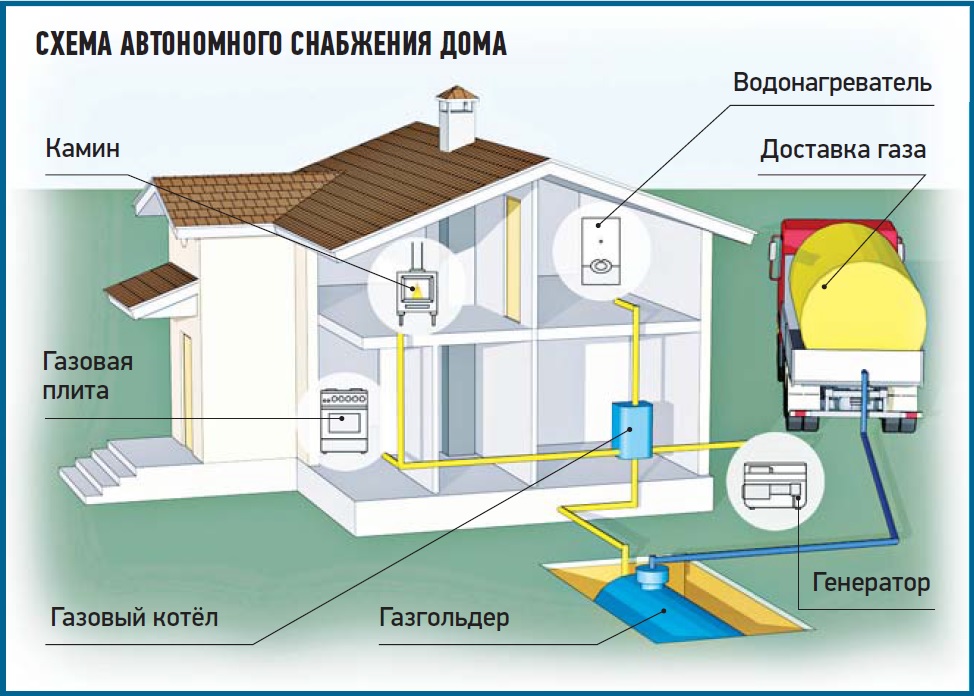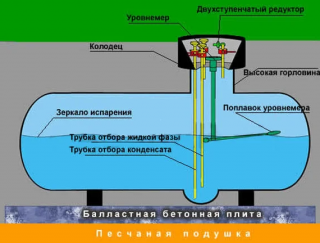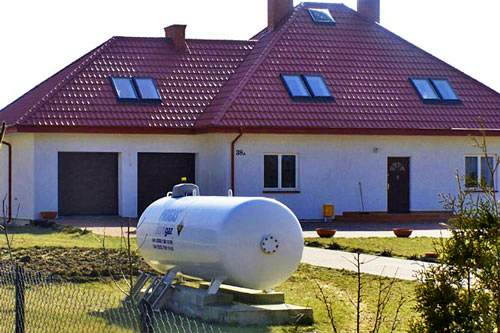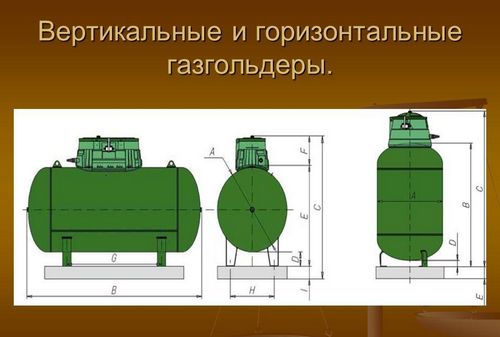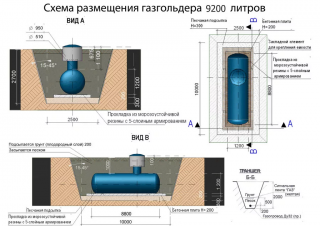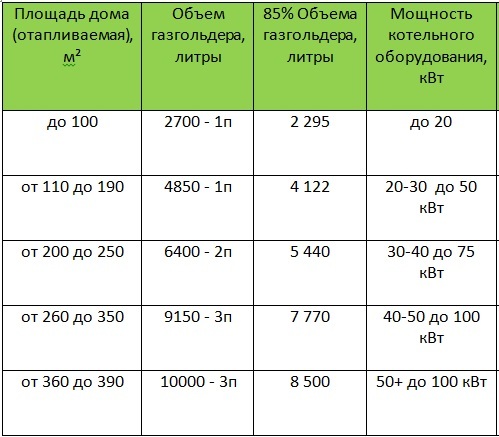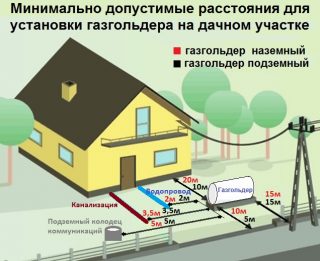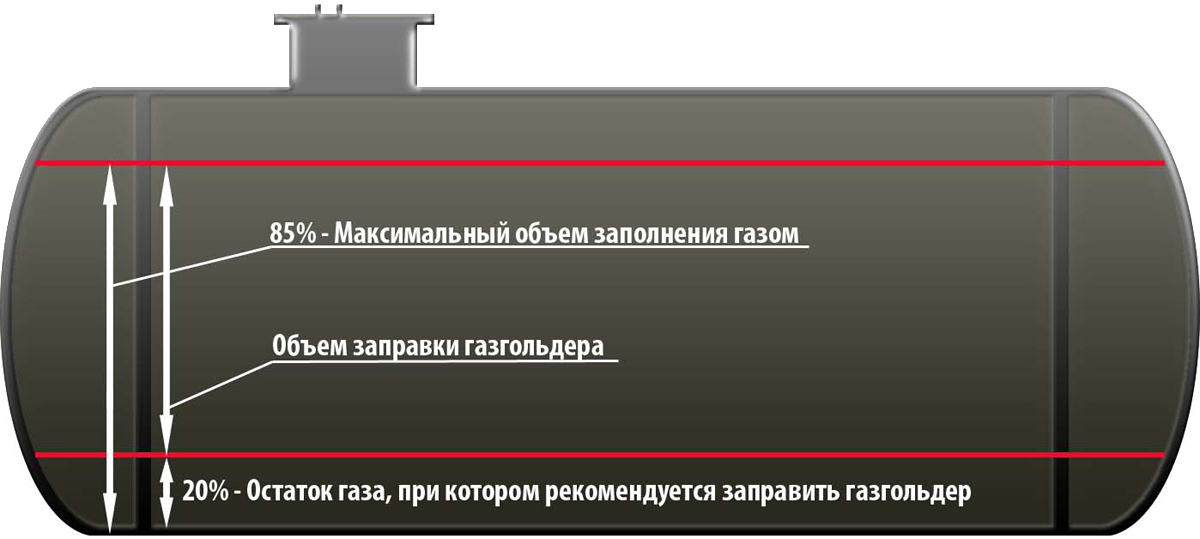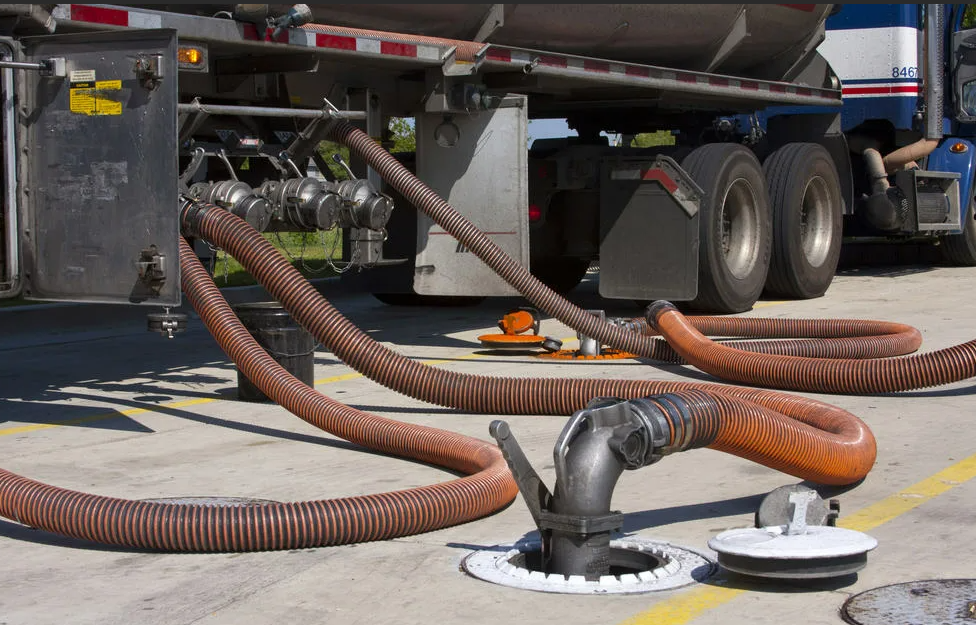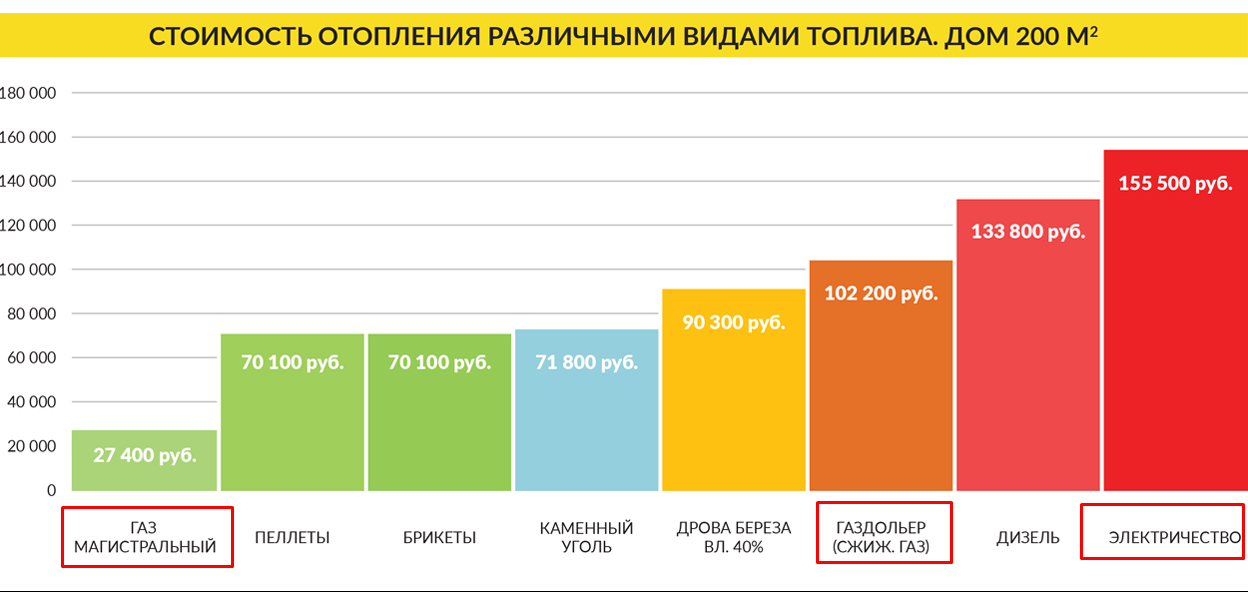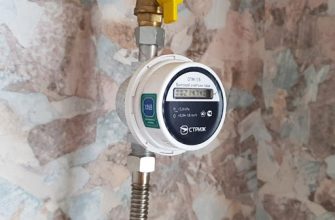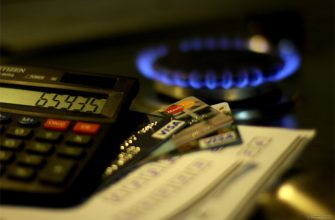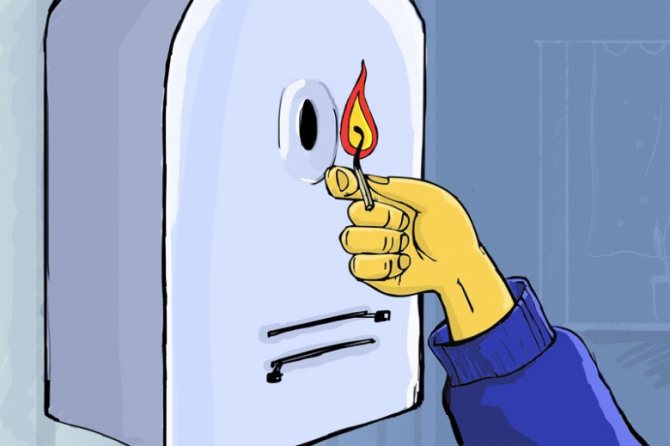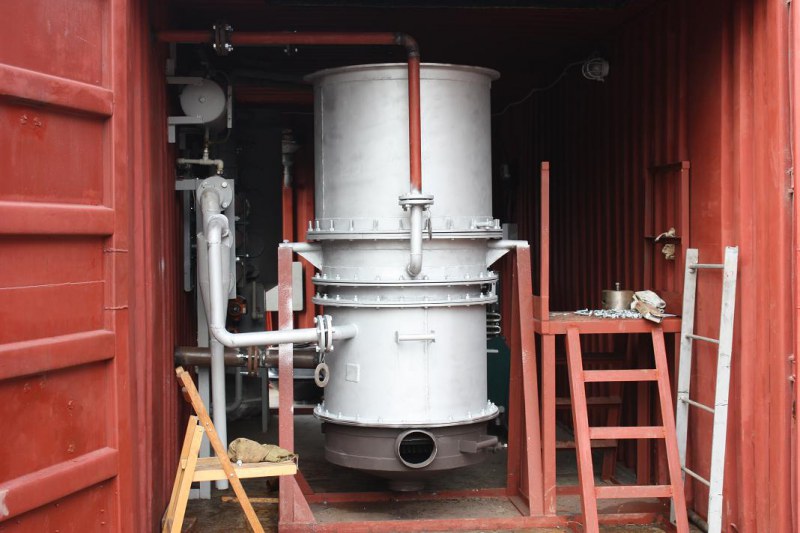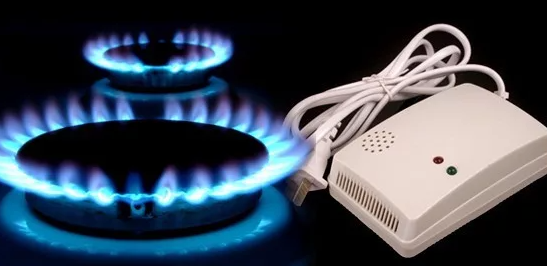In most of the settlements and dacha associations, there is no way to connect to centralized gas networks, or such a connection is expensive. It is possible to solve the problem of gas supply to suburban housing by installing a gas tank for a private house. When choosing equipment for storing fuel, they study the range of products and installation conditions.
- Description and principle of equipment operation
- Standard set of equipment
- Varieties of gas tanks
- Stationary and mobile
- Underground and above ground
- Horizontal and vertical
- Installation procedure
- Design and purchase of equipment
- Volume calculation
- Accommodation on the site
- Installation features
- Gas tank filling
- Comparison of economic indicators
Description and principle of operation of the equipment
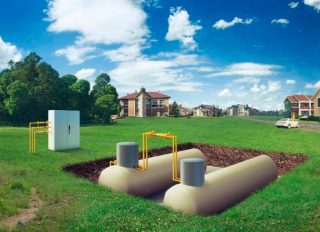
A gas holder is called an autonomous equipment for the storage of a significant volume of liquefied gas... In addition to one or several containers, the equipment includes devices for regulation, distribution and protection.
Stationary installations are equipped with containers from 2300 liters, it is not profitable to buy smaller devices, since refueling is enough for 1-2 months.Mobile gasholder can be equipped with a tank from 250 liters.
At the design stage, the estimated fuel consumption is calculated, taking into account the development of the site, climatic conditions.
Gas tanks store liquefied mixture of butane and propane... Methane is used for mobile cylinder-type installations. Methane gas tanks are filled only at specialized CNG filling stations.
The mixture delivered by special transport is pumped into the tank of the gasholder, leaving not less than 15% empty space. During evaporation, the upper free space is filled with a gas mixture.
Evaporation is possible when positive temperature... This is taken into account when ordering heating equipment or burying the tank underground.
By means of pumps, the fuel enters the pipeline, then to the consuming devices. Mobile options work on a similar principle.
Standard set of equipment
Capacity can fiberglass. It is easier to deliver and install, but the price is more expensive than steel. In the upper part of the container there is neckused for filling and drawing the mixture. Domestic manufacturers make long necks that allow the container to be buried in the ground so as not to heat it at low temperatures. Brackets are provided for attaching the tank to the base.
IN composition of additional equipment includes:
- valves - safety valves for pumping and withdrawing the mixture;
- gas residual control sensor;
- pressure gauge for correct adjustment;
- a reducer that reduces the pressure in the pipeline;
- device for collecting and draining accumulated condensate.
Some models and features of operating conditions require the installation of evaporator tanks.
Varieties of gas tanks
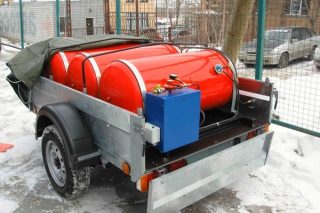
The range of manufactured products allows you to select a gas tank for gasification of any facilities. For the consumer, the geometric dimensions, orientation in space and the requirement for the installation site are important.
Stationary and mobile
Mobile gas tanks place on truck chassis, trailers or semi-trailers.Such installations are in demand at industrial facilities, the construction of which has not been completed, in summer cottages, in private houses, when it is impractical to install stationary models.
Underground and above ground
Ground installations are chosen for gas supply of small houses.
If the gas tank is supposed to be used for a long time, the underground type of installation is chosen.
Horizontal and vertical
The orientation of the tank in space can be vertical or horizontal.
Vertical models take up little space, so they are often placed on the surface. The area of the "mirror" of evaporation in such tanks does not allow obtaining a sufficient amount of the gaseous mixture in cold weather. The problem is solved by installing electric heaters or additional evaporators. Both options increase the cost of equipment, installation, commissioning and operation. It is recommended to choose vertical installations only for gas supply in southern regions with rare frosts.
By type of gas storage system there are constant and variable volume gas tanks... In the former, a high pressure is maintained, decreasing gradually as fuel is consumed. In tanks of the second type, there is a piston or a bell that moves vertically when the volume of gas changes.
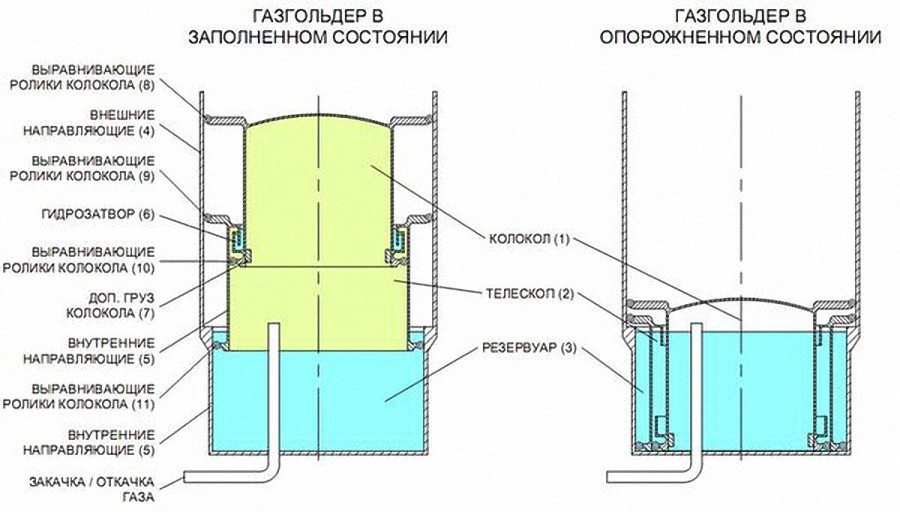
Installation procedure
Installation is carried out in several stages:
- project preparation;
- selection and purchase of equipment;
- installation;
- commissioning.
Registration with supervisory authorities gas tanks of entrepreneurs and legal entities are subject if the volume of tanks is more than 100 liters.
Gas tank installation on an individual site without registering does not provide for penalties, but the legislation can change at any time, so it is advisable to comply with all the nuances.
Design and purchase of equipment
The equipment is bought in large companies - they have cheaper equipment and a longer warranty.
Volume calculation
On average gas consumption influenced by the season, street temperature, type of gas tank, power of connected consumers.
According to many years of analysis, gas consumption for heating 1m² of house area is 25 liters per year for the Middle Lane. For the operation of a gas stove and a water heater, a 10% margin is provided. About 15% of the reservoir is not filled for correct operation.
Having carried out simple calculations, we can preliminarily say that for a house in 100 m², you need storage for 3200 liters, if you plan to refuel once a year. To save the initial investment, you can buy a container of a smaller volume, and refuel it 2 times a year.
The calculations are approximate, the exact numbers will be obtained from local equipment suppliers.
Accommodation on the site
- the entrance to the equipment for refueling must be with a hard surface;
- the foundation for the equipment can be reinforced concrete slabs or reinforced concrete with a thickness of 160 mm;
- the distance to open water bodies cannot be less than 50 m;
- the distance to buildings on the neighboring site is not less than 10 m for a tank volume of 10 m³;
It is forbidden to erect outbuildings and break lawns that provide for irrigation over underground storage facilities.
Installation features
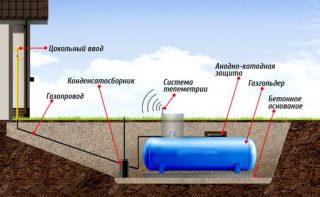
Installation rules for gas tanks are set out in the Codes of Rules, Fire Safety Rules, SNiP.
It is difficult to study and follow the instructions, an expensive tool is required for adjustment and maintenance, so it is advisable to conclude an agreement with a specialized organization.
During installation, be sure to pay attention to a few points:
- obligatory fastening of the tank to the base;
- external systems are carefully strengthened to prevent overturning and deformation from strong gusts of wind;
- pipelines are installed at a depth of at least 15 meters and at a slope of no more than 1%;
- provide for the possibility of cleaning the condensate collector;
- the upper point of the tank deepens at least 600 mm below ground level;
- shut-off, safety and control valves are mounted above the ground.
After the completion of installation and commissioning, an agreement is concluded for warranty and periodic maintenance.
Gas tank filling
To fill the tank, the optimal time is considered to be the period from February to July. Gas consumption is reduced and refueling services are cheaper. It should be borne in mind that the composition of the gas mixture can be winter or summer. In the first, the degree of volatility of hydrocarbons is higher. If gas is needed mainly for heating, winter LPG is chosen, if for cooking - summer LPG.
Refueling should be done when there is 25-30% fuel... First, you need to fix the meter readings in order to understand how much will be pumped. The process takes from half an hour to an hour. It is important to provide for this time site security - eliminate the risk of fire or gas explosion.
Contact gas suppliers with a license to carry out such work.
When refueling, adhere to the following rules:
- There must be at least 15% free space.
- The procedure is carried out only in daylight hours.
- The machine supplying gas must be secured wooden wheel chocks... Hose plugs can only be opened with the engine off.
- The drain hose is attached to the handpiece special clamps. Improvised means cannot be used.
- Experienced refuellers should participate in the process. special clothing... There must be at least two of them.

Comparison of economic indicators
Choosing between connection to gas distribution networks, installation of gas tanks or electric heating take into account:
- the cost of the necessary equipment and installation work;
- energy costs;
- maintenance and repair costs.
The most low connection cost for electricity... It is enough to install 2-3 supports, purchase a self-supporting insulated wire and suspensions for it. All material, installation of pillars and installation will cost 15-20 thousand rubles.
The cost gas supply depends on the distance to the street distribution network and may cost from several hundred thousand rubles.
Gas tanks for 2500 liters with full installation dispense from 150 thousand rubles depending on the manufacturer and the region.
Electricity price depends on the region, as well as the reduction factors for rural areas. Average consumption in winter is 1 kWh for 10 m² area.
Energy efficiency 1 kW of electricity is 0.1 kg of liquefied gas.
On average, 1 kW costs about 5 rubles, and 1 liter of gas is 24 rubles (0.1 kg 2.4), which is approximately 2 times less.
It is recommended to calculate the approximate cost of equipment and operation. in a few years and after that make a decision on the feasibility of installing a gas tank.


